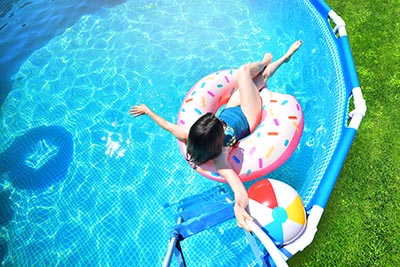
Planning your summer activity bucket list? Before doing so, Stephanie Lareau, an assistant professor of emergency medicine at the Virginia Tech Carilion School of Medicine, says a little common sense and the right preparation will go a long way in keeping your summer plans safe and fun.
1. Wear sunscreen or sun protective clothing
While it’s important year around, it’s very important during the summer to wear sunscreen or sun protective clothing such as sun shirts and hats when outdoors. Not only is sunburn uncomfortable but can also increase risk of skin cancer and predispose you to heat related illnesses. With sunscreen it’s important to re-apply every 2 hours, or more often if in the water. About 1 oz, which is a shot glass full is recommended.
2. Check for ticks
Tick borne illnesses are also common in summer months. It is important to check for ticks after being outdoors, especially in tall grasses or wooded areas. To remove ticks, use tweezers and grasp as closely to the tick’s head as possible to remove. Lyme disease is one of the more common tick borne illnesses. It can present with flu like symptoms including muscle aches, joint pain, fevers and a bull’s eye rash. We also see a lot of alpha gal allergy. This causes a red meat allergy and people often presents with allergy or even anaphylaxis after eating red meat. This comes from the lone star tick which is identifiable by a white spot on the tick’s back.
3. Wear a bicycle helmet
There is an uptick in trauma, especially pediatric trauma, during the summer. Make sure children (and adults) wear helmets when biking or using scooters.
4. Take a boat safety course
If you are spending time on the lake consider a boat safety course. Also watch the lake monitoring information for areas you shouldn’t swim. With heavy rains, agriculture and lawn chemicals and animal waste from farms can contaminate water making it unsafe for swimming.
5. Exercise early to avoid midday heat
Heat related illness is more common in summer months. Get outside early to avoid midday heat. Wear light colored, breathable clothing and make sure to drink plenty of fluids. Exercise tolerance can decrease when it’s hot, so plan accordingly and slowly increase exercise to help your body become acclimatized to increasing temperatures. Adjust your activities accordingly, on days with high heat index consider going for a swim or running on a treadmill indoors instead of running outdoors.
6. Stay hydrated while doing outdoor chores
If you work outdoors during the summer, it’s important to stay well hydrated. A good rule of thumb is making sure your urine looks light yellow to clear. Make sure you have water available and are drinking it at regular intervals. Take frequent breaks and get out the sun. If possible, try to get work done in the early morning or late evening when the temperatures are lower. Look at the forecast and try to pick days with not only lower temperatures but lower heat index, which takes into account both temperatures and humidity. When the humidity is high, sweating is less effective, making it harder for your body to regulate temperature.
7. Take swim lessons; wear a life jacket when needed
There is also an increase in drowning during the summer. Make sure to have a designated person to watch children around water. Make sure children have well-fitting life jackets on in lakes and rivers. It’s also a great time to get children enrolled in swimming lessons. If you witness someone drowning, early CPR with rescue breaths in vital to improving chances of survival while waiting for help to arrive. Consider taking a CPR class.
8. Check water levels before tubing
If you’re planning to tube or float a river, make sure to check water levels before you go. Websites such americanwhitewater.org show levels. If you aren’t familiar with the levels check with a local outfitter before you go. Many rivers that are fun for tubing at low levels can be very dangerous at high levels and have new hazards. Everyone should wear a life jacket while on moving water. Alcohol is also associated with an increased risk of drowning, even in good swimmers. It’s also important to know dangers in waterways like low-head dams to avoid boating accidents. Additional danger can come from down trees and debris in rivers after storms. Consider taking a water safety course if you enjoy recreating on rivers.
9. Prepare for longer hikes and outdoor activities
When taking longer trips in the summer it’s important to have adequate access to water and remember in hot weather you make need more water than usual. If you are planning on obtaining water from streams or creeks, talk to those familiar with the area to make sure they aren’t dry. If you are doing strenuous activities, it can also be important to include electrolyte drinks as well to avoid exercise induced hyponatremia. Hyponatremia mean low sodium or salt levels, which can lead to confusion and even seizures.
If you are on medications for blood pressure, heart problems or psychiatric conditions it is worth talking to your doctor about these medications and your outdoor plans. Some medications can predispose to heat illness or dehydration. As with any outdoor activity, it’s also helpful to get acclimated to the heat before embarking on ambitious adventures.
It’s also important to have a plan if you get stuck in bad weather. The Southeast region typically sees a lot of pop-up storms over the summer. Have a plan to seek shelter and stay dry.
10. Prevent heat stroke
The most serious medical problem is related to summer heat is heat stroke. Any time someone is out in the heat and starts having altered mental status this is heat stroke. Altered mental status could be confusion or not being able to walk correctly, this is a medical emergency and potentially life threatening. You should call 911 and work on cooling the person down. Simple things like spraying them with cool water, immersing them in water (if they are awake and able to help) and getting them out of direct sun can help while you are awaiting more help.










